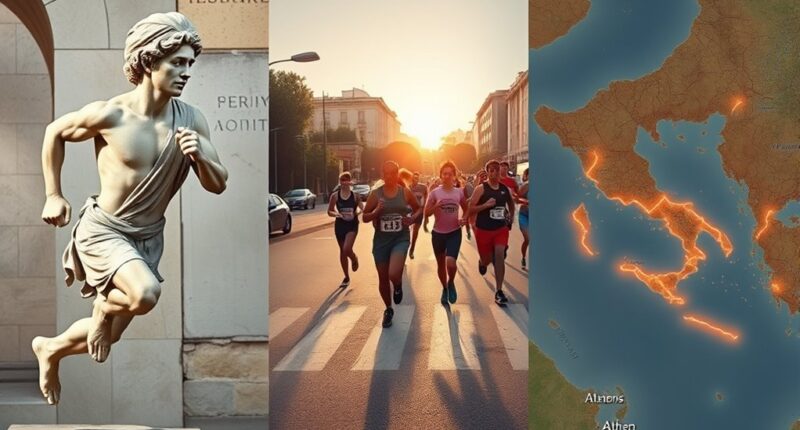The origins of the marathon date back to ancient Greece, inspired by a legendary run by Pheidippides, who ran about 26 miles from Marathon to Athens to deliver victory news. This heroic act symbolized endurance, patriotism, and heroism, blending history with mythology. Over time, the race evolved into a modern athletic event with scientific training methods and advanced technology. If you want to explore how this ancient story shapes today’s races, there’s much more to uncover.
Key Takeaways
- The marathon originates from ancient Greece, inspired by Pheidippides’ legendary 26-mile run to deliver victory news.
- Greek mythology and heroic ideals influenced early athletic pursuits emphasizing resilience and endurance.
- Modern training methods, including interval and long-distance runs, have evolved from ancient spontaneous efforts.
- Technology like GPS and heart rate monitors now optimize training, contrasting with ancient rudimentary techniques.
- The marathon symbolizes human endurance, blending mythological roots with contemporary sports science and continuous evolution.

The origins of the marathon trace back to a legendary event in ancient Greece, where a messenger named Pheidippides ran approximately 26 miles from the battlefield of Marathon to Athens to deliver news of a Greek victory. This story blends history and Greek mythology, symbolizing endurance and patriotism. While some details may have been embellished over time, the core idea remains powerful: a single, fearless run that changed the way we view long-distance racing. Today’s marathon echoes that epic journey, but it’s also shaped by modern training methods that help runners prepare for such grueling distances.
The legendary run of Pheidippides from Marathon to Athens embodies endurance and historic heroism.
In ancient Greece, stories from Greek mythology inspired many aspects of life, including athletic pursuits. The gods and heroes celebrated in myth often represented ideals of strength, resilience, and endurance—values that marathon runners aim for today. These stories emphasize the importance of mental toughness and physical stamina, qualities you need to conquer a marathon. The mythological significance of perseverance fuels many runners’ motivations, connecting ancient legends to modern athletic achievement.
Today, however, training methods have evolved far beyond the simple, spontaneous runs of ancient times. Modern runners rely on scientifically backed approaches that maximize performance and reduce injury risk. You might incorporate interval training, which alternates high-intensity sprints with recovery periods, to boost your stamina. Long runs build your endurance gradually, mimicking the historic 26-mile distance, but with careful planning to prevent overtraining. Cross-training, strength exercises, and proper nutrition are also essential components of contemporary marathon preparation, helping you develop a balanced, resilient body capable of handling the physical demands of the race.
Advanced technology plays a significant role in training today. GPS watches track your pace and distance, while heart rate monitors ensure you’re training within ideal zones. Many runners now use data analysis to refine their routines, making each session more effective. These modern methods contrast sharply with the rudimentary training of ancient athletes, yet both aim for the same goal: pushing beyond limits to achieve greatness.
In essence, the marathon’s origins are rooted in myth and history, but it’s the continuous evolution of training techniques that keeps the race relevant. Whether inspired by Greek mythology’s stories of heroism or driven by cutting-edge training tools, you’re part of a tradition that celebrates human endurance. Every mile you run echoes the legendary run of Pheidippides, connecting you to a rich history while propelling you forward with the latest in sports science.
Frequently Asked Questions
How Did the Marathon Become an Olympic Event?
You see, the marathon became an Olympic event due to its rich history and cultural significance. In 1896, the modern Olympics adopted it to honor the legendary run of Pheidippides, symbolizing endurance and perseverance. Over time, the race’s evolution reflected the importance of physical fitness and international unity, making it a key highlight that celebrates human spirit and athletic achievement, connecting ancient traditions with contemporary sporting excellence.
What Are the Modern Marathon World Records?
You’re probably imagining someone running like the wind, but modern marathon world records tell a different story. The men’s record stands at 2:01:39, set by Eliud Kipchoge, and the women’s at 2:14:04 by Brigid Kosgei. Thanks to history of running and marathon shoe technology, athletes now shave minutes off their times. So, next time you dash to catch the bus, remember—these records make your sprint look like a leisurely jog!
How Is Marathon Training Different Today Than in Ancient Times?
Today, you train with advanced methods like interval runs, long-distance workouts, and cross-training, unlike ancient runners who relied on basic endurance. Nutritional strategies play a vital role now, emphasizing carbs, hydration, and recovery foods to optimize performance. You also benefit from modern gear, scientific coaching, and data tracking, enabling more efficient progress. Ancient runners focused on sheer endurance and simplicity, whereas you utilize technology and science to enhance your marathon preparation.
What Other Sports Originated From Ancient Greece?
Imagine stepping into a grand stadium, echoing with the roars of ancient crowds. You discover that sports like wrestling, chariot racing, and the pentathlon all have Greek origins, showcasing their rich ancient sports tradition. These activities, rooted in Greek origins, emphasized strength, agility, and strategy. By understanding these ancient roots, you gain a deeper appreciation of how modern sports continue to reflect the athletic spirit of ancient Greece.
How Has Marathon Race Technology Evolved Over the Years?
You’ve seen how marathon race technology has evolved remarkably. Running shoe innovation now features lightweight materials, cushioned soles, and responsive designs that boost performance and comfort. Pacing technology, including GPS watches and apps, helps you monitor your pace precisely, ensuring ideal race strategies. These advancements allow you to run farther and faster than ever, combining tradition with modern innovation to enhance your marathon experience considerably.
Conclusion
So, here you are, running a race inspired by a messenger’s desperate dash to save Athens. Ironically, what was once a life-or-death mission has become a celebrated sport, enjoyed worldwide. Today, you chase a finish line, not an empire’s survival. The marathon’s origins remind you that even the most serious history can stumble into a humorous, competitive tradition—proof that sometimes, humanity’s greatest achievements start with a simple, frantic run.









